
Rest in peace, Mocha and Willie (but not you, Kato—you're not dead yet...)
Where the spark of intelligence never quite catches fire.

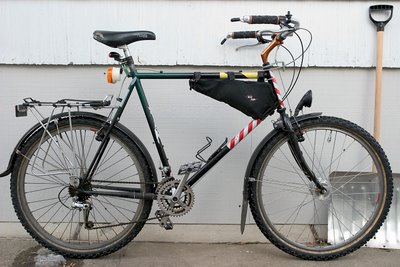
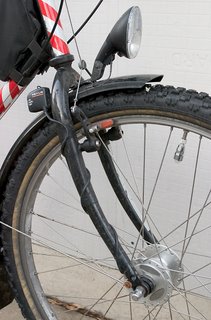
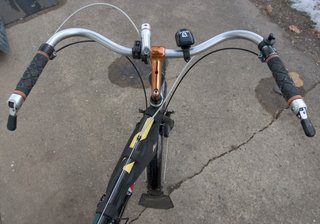



We currently have one single sample for us to testride and I just got done with my three weeks of testing on it. Here are the results, mainly in comparison to my Instigator frame with the Xtracycle Free Radical bolt-on.
During city commutes with a normal load, the bike is noticeably quicker and more nimble in handling. It's about 1 1/2 pounds lighter just in the frame and fork, yet it's torsionally stiffer and does not fishtail like the Insti/FreeRad. The nice vertical compliance that is inherent in long frames is still there, but it has lessened a bit. With the slight bouncing feeling I got when I'd hit small bumps on my Insti/FreeRad virtually eliminated, it rides much more like a normal bike.
One day I loaded it down with two 5-gallon kegs of beer, a soundsystem and another 40 pounds of stuff. All total the load was about 200 pounds in addition to myself, right around the intended weight limit. This size load would've truly kicked my butt on the Insti/FreeRad, but on the Big Dummy I was able to ride it like a bike without the load dominating my every move. My lower back wasn't forced to sit on the seat to stabilize the load the whole day and I ended up putting about 30 miles on it, both on and off road. Sure, my legs were cooked, but it was nice to know was the Dummy was capable of whatever I was capable of.
Day by day I found myself more comfortable with the geometry and was darting through traffic without having to manhandle it. I never once thought I was at a disadvantage in tight situations while at speed. I even ripped a small section of singletrack much faster on the Dummy than the Insti/FreeRad, proving the off road capabilities are improved. Seriously folks, getting a long-wheelbased bike through a corner and occasionally getting a two-wheel drift is a total blast. Imagine having the your weight loaded equally on both front and back wheels without the real threat of endo-ing, and you'll get yourself going faster than you'd ever think you could go.
Overall, I'm extremely happy so far with this preliminary version of the Big Dummy. We still have some things to tweak and more prototypes coming to test this winter, but the results will only get better.
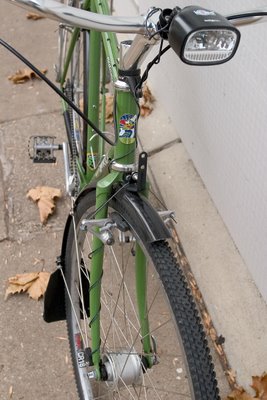



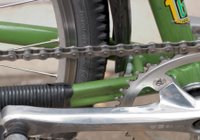

Dictionary definitions aside, the common connotation of the term accident is something that was unavoidable, unplanned, unpredictable, unpreventable, etc. In common usage, the term accident implies that no one was responsible for what happened. Most traffic crashes, however, are both predictable and preventable.
[...]
Calling these incidents crashes or collisions allows us to get away from the blamelessness that the term accident implies, and get on with the task of addressing the human behaviors that lead to these occurrences on a predictable basis so that they can be prevented.
Wisconsin DOT statistics indicate that something on the order of 80% + of reported traffic accidents are caused by driver error. In the 1989 edition of Wisconsin Traffic Accident Facts, at the bottom of page 1, is the following:Accidents to be called Crashes
Traffic crashes are not accidents, but avoidable events caused by a single variable or chain of variables. We are dedicated to reducing traffic injuries and fatalities by addressing the factors that cause them. During this transition year, the 1989 edition of Accident FACTS uses the term "accident." Future editions will incorporate "crash" into the text and will be entitled Crash FACTS.
[The Public Information Officer] of the East Police Precinct called me early this morning to report on a motorcycle-van crash which occurred at about 9:30 pm Friday night at the corner of Atwood and Jackson streets. The crash resulted in the death of the motorcyclist and critical injury to the van driver. As of this morning, the van driver, a woman, was in critical condition.
Police spotted 3 motorcyclists driving west on E. Washington Avenue at 100 MPH. Police gave chase, and two of the motorcyclists pulled over. The third continued at a high rate of speed toward the downtown. Near downtown, another squad began the chase, and the motorcyclist turned (I don't know where), got onto Williamson St., and began driving east. The police officer ceased pursuit at about Baldwin.
The motorcyclist continued onto Atwood. Police do not know how the driver collided with the van.
Please stop using the word "accident" to describe "crashes." This is a horrible tragedy, but it wasn't an "accident." It's a clear example of why most crashes are NOT accidents—a motorcyclist evading police and driving at 100 MPH is almost inevitably going to end up crashing. There's nothing unpredictable, and certainly nothing unpreventable, about it.
One of the first steps to changing the culture that seems to think it's normal for drivers to kill more than 40,000 people a year, and seriously injure half a million more, is to change the language. Crashes are not accidents. (OK, it's possible that some tiny percentages of crashes fit the common understanding of the word "accident," but that doesn't mean it's OK to call all of the crashes that are predictable and easily predictable "accidents").
If you don't think that language matters, then consider "defense of marriage" vs. anti-gay legislation, and "Right to Life" vs "Pro Choice." Wherever you stand on those polarizing issues, it is absolutely clear that language matters, and when it comes to CRASHES, the Wisconsin Department of Transportation agrees. [see above]


"Many people think I am either stupid, insane, or foolish for riding busy roads to Sun Prairie," said Swartz.Certainly the ideal for any bicycle commuter, but there's more to it:
"This should not be the case. I should have routes to use that would not lead people to that conclusion. . . . We need safe routes to (Sun Prairie) and other destinations for the novice and average rider in all conditions, the temperature, precipitation, light and hour of day."
"Look at it this way," Swartz added, "there is the obesity epidemic, land-use decisions, private property rights, public transportation costs, gasoline prices. They are all integrated. With gas (headed toward) $4 a gallon, people will start thinking twice before they build."I was a little surprised to see those quotes in print...
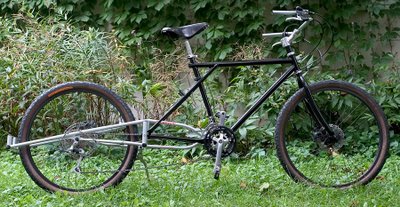
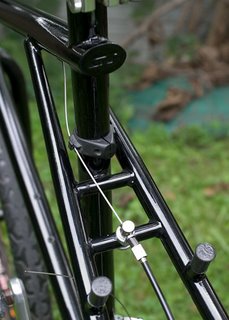
Cars Are Like Glass Houses
By Robert Allen
Bicycles are for transportation, not personal transformation. Riding a bicycle won’t turn a sinner into a saint.
But this doesn’t stop some motorists from expecting more than normal human behavior from every bicycle rider they see.
Anti-bicyclist letters to the editor in local papers are becoming drearily common, denouncing all who dare ride bicycles because of the antics of a rude and careless few. Of course, such letters are a benign and preferable form of backlash compared to the aggressive messages delivered along the road by some impatient motorists.
But I wonder why the letter writers, or anybody, would think bicyclists should be held to a higher standard than the rest of society.
Of course some bicyclists are rude and dangerous and they are wrong when they act selfishly and stupidly.
Riding a bicycle can help you shed pounds, save on gas and have more fun -- but it’s not going to change the content of your character. If you’re a rude and selfish jerk before you get on your bicycle, you’ll probably remain one no matter how many miles you ride.
People who focus their invective on bicyclists seem curiously complacent when it comes to dangerous and distracted motorists, who pose a much bigger threat to the health and welfare of any community.
Motorists are armed with tons of metal capable of much higher speed. The simple physics of the equation spells trouble. Add distractions like the scourge of cell phone addiction to this motorized mix and there are plenty of reasons for concern, if not a Sisyphusian stream of angry letters.
But there is something about the sight of a lone bicyclist blowing through a stop sign that sends the motoring public over the edge.
Perhaps it’s because bicyclers who ignore stop signs seem to be saying to the world that they think they’re above the law.
It’s a point well taken. Bicycles have an equal right to the road in Wisconsin, and with that right comes the responsibility to observe the same laws motorists occasionally observe.
But while I don’t condone it or recommend it, I know why bicycle riders are reluctant to scrub all the speed they’ve worked to build up at stop signs guarding empty intersections.
They aren’t doing it to thumb their noses at the world. They roll through intersections when the coast is clear because the cost of stopping for bicyclists is more directly felt than it is by drivers.
For a bicyclist, starting from a dead stop requires a considerable physical effort, much more exertion than simply maintaining pace. A driver who stops merely has to press down on the gas pedal a bit and, Bob’s your uncle, you’re back up to speed (never mind the extra blast of hydrocarbon emissions you’ve just delivered).
This isn’t an excuse, but maintaining hard-earned momentum is a compelling reality for the self-propelled.
A stop sign, however, means stop. It shouldn’t be treated like a yield sign.
I do my best to make a point of stopping fully, especially when being observed, not just because it’s the law; as a bicycling advocate, I try to be a decent ambassador out there on the road.
Not that my efforts to ride lawfully and courteously are going to change anybody’s mind. Courteous riders, like courteous drivers, are certainly in the majority. They just aren’t the ones anybody notices.
There are all kinds of people riding bicycles and driving cars. The next time one of them does something foolish, don’t hold it against the rest of us.
Allen is a commuting and recreational bicycler who lives in Middleton.


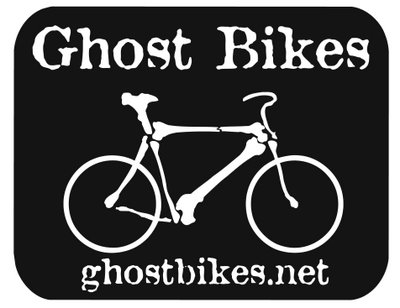



Increasingly sophisticated bicycles are being designed to transport people as well as the accoutrements of their daily lives. Special bicycles and tricycles can haul items such as furniture and building supplies. And they're catching on in bicycle-friendly cities such as Madison.


The U.S. lives in an energy trap. We fell into it gladly, dug it deeper and sit fat and happy, with blinders on. We're fed daily meals of imported oil, from countries we pay in IOUs and think we can push around. But now we're starting to see the costs and risks of our dependency—and I don't only mean gasoline averaging $2.74 a gallon at the pump.
For years to come, we'll be in the hands of some of the most dysfunctional governments in the world. Oil prices will rise and economic growth will slow—not this year, but almost certainly a few years out. We'll be paying in both treasure and blood, as we fight and parley to keep ever-tighter supplies of world oil flowing our way.
What has changed in the world? We're running out of the capacity to produce surpluses of oil. Demand for crude is expected to rise much faster than new supplies. Developing nations, such as China and India, are glugging barrels at astounding rates. Meanwhile, most producer nations can't find enough new oil, or drill out more from their reserves, to replace what we're using up. Production from most of the large, older fields is in irreversible decline. [Emphasis added]
On paper, we have alternatives, such as liquefied coal, oil sands from Canada and ethanol. But they're not anywhere close to production on a massive scale. For a smooth transition, mega-energy projects need to get started at least 20 years before oil supplies decline, writes Robert Hirsch of the consulting firm SAIC in a study prepared for the U.S. Department of Energy. If we don't get a running start on the problem, he says, "the economic consequences will be dire." We're probably already behind. It takes leadership to address a potential crisis in advance.
Unfortunately, we're investing in war, not in crash projects to develop new energy sources. Maybe there's time to spare. But some events, like true civil war and collapse in Iraq, could change everything in a day. We're running a faith-based energy policy—still addicted to oil. If something goes wrong, it will go wrong big.




Cargo Without the Car
by Robert Allen
Another time. Another war. And Americans were asking themselves “Is this trip really necessary?”
Supporting the troops during the Second World War meant more than slapping a sticker on the car. It meant thinking twice before driving that car.
Years later, I remember hearing my grandparents and parents asking the question, even as cheap gas and Detroit muscle were making car use as reflexive as breathing for most Americans.
The question seemed quaint then. It’s not so quaint today.
Another war. Uncertain oil supplies. Climate change. Gridlock. Obesity. Take your pick. There’s more than one reason to begin questioning the necessity of car trips.
The bicycle provides an obvious way to make unnecessary many trips that once were made in a car.
But many of us who already use a bicycle to get ourselves to work or around town now and then still hop in the car to haul groceries or other household goods. We’re willing to carry ourselves on bicycles, but get flustered by the challenge of carrying much else.
A few years ago, I began rediscovering the types of bags and racks I knew as a kid, relatively modest ways to carry a few things on a bicycle. As a recovering racer, it’s taken me a long time to overcome the racer’s weight fetish for the sake of such practicality.
But the payoff of using even a modest bag or rack is an immediate improvement in the enjoyment of almost any ride. Having a place to shed or acquire layers of clothing helps cope with changing weather, and this stretches the riding season. Food, maps, tools, a spare inner tube or camera are pretty handy to have around.
A decent sized bag, basket or rack means a rider can suddenly run more errands. But even the big old saddlebag on my three-speed quickly reaches its limit, long before I can cross a grocery run off the necessary list.
The real limit, though, is only of one’s imagination. A growing number of riders are finding ways of increasing their carrying capacity to a point where the car is much less necessary in their lives.
One such rider is Michael Lemberger, a Madison graphic artist who currently is adding a second Xtracycle cargo bike to his family’s stable. A little over a year ago, Lemberger converted one of his bikes using an Xtracycle kit. He’s now converting another bike for his wife Gloria, a ceramic artist.
The conversion kit moves the rear wheel back 15 inches, stretching the bike to accommodate an impressive array of bags and carrying surfaces. The extra length has obvious benefits, while allowing a rider to carry wide loads without hitting the load with his or her heel on the backstroke of the pedaling motion.
Lemberger has carried many bags of groceries on his “long bike”. He’s come back from building supply centers carrying everything from insulation to two-by-fours. He’s added some handlebars to his rig so his 7-year-old daughter Olive can enjoy riding in back.
For the sake of a photograph, he strapped on two 55-gallon barrels (though sanity took hold before we tried to fill them up to truly test the manufacturer’s suggested weight limit).
An Xtracycle’s claimed cargo capacity is about 200 pounds. Add a rider and the total ballast you might try to pedal up a hill would be about 400 pounds. Lemberger hasn’t tested that limit, though he says a loaded Xtracycle is surprisingly stable.
Xtracycle kits are available in some Madison shops, as is installation services for the less mechanically adventurous. You can learn more at www.xtracycle.com. Or check out www.rideyourbike.com/xtracycle.html for a gallery of longbike riders carrying amazing loads.
Of course, there are other ways to increase your bicycle’s carrying capacity. Many riders, from long-distance touring cyclists to local grocery haulers, favor any of the increasingly sophisticated trailers on the market. Visit www.bikesatwork.com for one Iowa maker’s take on trailers.
One advantage of a trailer is that you can disconnect it easily to lighten up your machine when not carrying cargo.
Another advantage is that trailers keep the weight of the load off the bicycle, allowing the bike to use much lighter wheels than would be required for carrying heavy loads. Lighter wheels help a bicycle feel much more responsive because light wheels have less rotational weight for a rider to propel. This is why racing bike builders, while always concerned about the overall weight of the machine, go to especially extreme lengths to shave grams off the wheels.
Lemberger, however, likes the feel of two wheels. He believes two wheels, even if relatively heavy wheels, create less rolling resistance than the four wheels of a bicycle and trailer rig.
Of course, trikes are yet a third option, allowing a large cargo carrying space behind the rider between the back wheels. See some classic workhorses as www.worksman.com.
Two, three or four wheels, isn’t the issue. There are many ways to increase self-propelled carrying capacity and decrease reliance on motor vehicles. People in other parts of the world, especially where cars aren’t even an option, are well familiar with many cost-effective options.
At about $400, an Xtracycle kit isn’t exactly cheap. But if it decreases your reliance on a car enough, it will pay for itself rather quickly.
Lemberger isn’t a purist. He and his family of three still own a car. “We’re not car free,” he said. “But we’re car-light.”
Of course, that puts them far ahead of many of us, including your author. And this is what got me thinking of that quaint old question about what trips truly are necessary.
Reducing dependence on the automobile is more about attitude than equipment. It also requires a certain degree of fitness and physical abilities that are not universally shared.
But for those with the needed physical abilities, which includes a vast number of today’s car addicts, a real commitment to reducing auto use will inevitably carry with it the benefit of increasing fitness. Increase fitness enough and you, too, could be testing yourself to see how much cargo you can haul up that hill from the grocery store.
Don’t start out with bags of cement or 55 gallon barrels. Think about smaller errands carrying items you could fit in a small bag or even a large pocket.
“You have to wonder how many car trips are made that could be done on a bike or by walking,” Lemberger said. “There are an awful lot of car trips made to return a DVD or a library book.”
Are those trips really necessary?
Allen is a commuting and recreational bicycler who lives in Middleton.
[...] I drive a hybrid car, have solar panels, do all those eco-friendly things, I don't feel like I'm sacrificing. I feel smarter, I feel like I'm part of the solution [...]